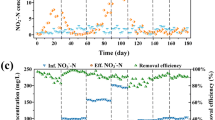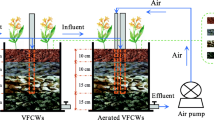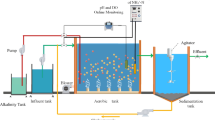Abstract
Nitrogen removal by anammox process has been recognized as efficient, cost-effective, and low-energy alternative removal. The longer start-up periods of anammox process hindered the widespread application of anammox-based technology. In this study, four identical unplanted subsurface-flow constructed wetlands (USFCWs) were built up to investigate the effects of electron acceptors (Fe3+, Mn4+, SO42−) on the start-up of anammox process. Results indicated that the start-up time of anammox process was shortened to 105 days in R1 (with Fe3+ addition) and 110 days in R2 (with Mn4+ addition) with nitrogen removal efficiencies of above 75%, compared with 148 days in R0 (control). The addition of SO42− had no significant effect on start-up process. High-throughput sequencing results demonstrated that Shannon index increased significantly from 2.87 (R0) to 5.08 (R1) and 5.00 (R2), and the relative abundance of Candidatus Anammoxoglobus rose from 3.6 to 5.3% in R1. Denitratisoma increased significantly in R2 under addition of Mn4+, which was beneficial for the occurrence of anammox process. The functional genes that related to signal transduction mechanisms and secondary metabolite biosynthesis, transport, and catabolism were upregulated after addition of electron acceptors. These results demonstrated that adding electron acceptors Fe3+ or Mn4+ could be an effective way to accelerate the start-up of anammox process.

ᅟ






Similar content being viewed by others
References
Ali M, Oshiki M, Rathnayake L, Ishii S, Satoh H, Okabe S (2015) Rapid and successful start-up of anammox process by immobilizing the minimal quantity of biomass in PVA-SA gel beads. Water Res 79:147–157
APHA (1998) Standard methods for the examination of water and wastewater. American public health association, Washington, DC
Bi Z, Qiao S, Zhou J, Tang X, Zhang J (2014) Fast start-up of Anammox process with appropriate ferrous iron concentration. Bioresour Technol 170:506–512
Chen H, Yu JJ, Jia XY, ** RC (2014) Enhancement of anammox performance by Cu (II), Ni (II) and Fe (III) supplementation. Chemosphere 117:610–616
Chi YZ, Zhang Y, Yang M, Tian Z, Liu RY, Yan FY, Zang YN (2018) Start up of anammox process with activated sludge treating high ammonium industrial wastewaters as a favorable seeding sludge source. Int Biodeterior Biodegrad 127:17–25
Chu Z, Wang K, Li X, Zhu M, Yang L, Zhang J (2015) Microbial characterization of aggregates within a one-stage nitritation–anammox system using high-throughput amplicon sequencing. Chem Eng J 262:41–48
Dong Z, Sun TA (2007) Potential new process for improving nitrogen removal in constructed wetlands promoting coexistence of partial-nitrification and ANAMMOX. Ecol Eng 31(2):69–78
Fdz-Polanco F, Fdz-Polanco M, Fernandez N, Urueña MA, Garcia PA, Villaverde S (2001) Combining the biological nitrogen and sulfur cycles in anaerobic conditions. Water Sci Technol 44(8):77–84
Gao C, Wang A, Wu WM, Yin Y, Zhao YG (2014) Enrichment of anodic biofilm inoculated with anaerobic or aerobic sludge in single chambered air-cathode microbial fuel cells. Bioresour Technol 167:124–132
Gonzalez-Martinez A, Muñoz-Palazon B, Rodriguez-Sanchez A, Gonzalez-Lopez J (2018) New concepts in anammox processes for wastewater nitrogen removal: recent advances and future prospects. FEMS Microbiol Lett 365(6):fny031
Hulth S, Aller RC, Gilbert F (1999) Coupled anoxic nitrification/manganese reduction in marine sediments. Geochim Cosmochim Acta 63:49–66
Lavrova S, Koumanova B (2010) Influence of recirculation in a lab-scale vertical flow constructed wetland on the treatment efficiency of landfill leachate. Bioresour Technol 101:1756–1761
Li X, Huang Y, Yuan Y, Bi Z, Liu X (2017) Startup and operating characteristics of an external air-lift reflux partial nitritation-ANAMMOX integrative reactor. Bioresour Technol 238:657–665
Lin H, Taillefert M (2014) Key geochemical factors regulating Mn (IV)-catalyzed anaerobic nitrification in coastal marine sediments. Geochim Cosmochim Acta 133:17–33
Lotti T, Kleerebezem R, Lubello C, Van Loosdrecht MCM (2014) Physiological and kinetic characterization of a suspended cell anammox culture. Water Res 60:1–14
Luther GW, Sundby B, Lewis BL, Brendel P, Silverberg N (1997) Interactions of manganese with the nitrogen cycle: alternative pathways to dinitrogen. Geochim Cosmochim Acta 61:4043–4052
Magri A, Vanotti MB, Szogi AA (2012) Anammox sludge immobilized in polyvinyl alcohol (PVA) cryogel carriers. Bioresour Technol 114:231–240
Mulder A, van de Graaf AA, Robertson LA, Kuenen JG (1995) Anaerobic ammonium oxidation discovered in a denitrifying fluidized-bed reactor. FEMS Microbiol Ecol 16:177–183
Qiao S, Bi Z, Zhou J, Cheng Y, Zhang J, Bhatti Z (2012) Long term effect of MnO2 powder addition on nitrogen removal by anammox process. Bioresour Technol 124:520–525
Ren Y, Li D, Li X, Yang L, Ding A, Zhang J (2014) High-rate nitrogen removal and microbial community of an up-flow anammox reactor with ceramics as biomass carrier. Chemosphere 113:125–131
Strous M, Heijnen JJ, Kuenen JG, Jetten MSM (1998) The sequencing batch reactor as a powerful tool for the study of slowly growing anaerobic ammonium-oxidizing microorganisms. Appl Microbiol Biotechnol 50:589–596
Thamdrup B, Dalsgaard T (2000) The fate of ammonium in anoxic manganese oxide-rich marine sediment. Geochim Cosmochim Acta 64:4157–4164
Tomar S, Gupta SK, Mishra BK (2016) Performance evaluation of the anammox hybrid reactor seeded with mixed inoculum sludge. Environ Technol 37:1065–1076
Van de Graaf AA, de Bruijn P, Robertson LA, Jetten MSM, Gijs Kuenen J (1996) Autotrophic growth of anaerobic ammonium-oxidizing micro-organisms in a fluidized bed reactor. Microbiology 142(8):2187–2196
Van Dongen U, Jetten MSM, van Loosdrecht MCM (2001) The SHARON-Anammox process for treatment of ammonium rich wastewater. Water Sci Technol 44(1):153–160
Wang D, Liu B, Ding X, Sun X, Liang Z, Sheng S, Du L (2017) Performance evaluation and microbial community analysis of the function and fate of ammonia in a sulfate-reducing EGSB reactor. Appl Microbiol Biotechnol 101(20):7729–7739
Zhang L, Yang J, Ma Y, Li Z, Takao F, Zhang W, Takashi N, Furukawa K (2010) Treatment capability of an up-flow anammox column reactor using polyethylene sponge strips as biomass carrier. J Biosci Bioeng 110(1):72–78
Zhang ZZ, Xu JJ, Shi ZJ, Bai YH, Cheng YF, Hu HY, ** RC (2017) Unraveling the impact of nanoscale zero-valent iron on the nitrogen removal performance and microbial community of anammox sludge. Bioresour Technol 243:883–892
Zhou GW, Yang XR, Li H, Marshall CW, Zheng BX, Yan Y, Zhu YG (2016) Electron shuttles enhance anaerobic ammonium oxidation coupled to iron (III) reduction. Environ Sci Technol 50(17):9298–9307
Funding
This work was financially supported by the National Key R&D Program of China (No. 2018YFD0800904; No. 2017YFC0505901), National Natural Science Foundation of China (No. 41401548; No. 41772244), and China Scholarship Council (Nos. 201804910339 and 201806175055). The study is supported by Key Laboratory of Groundwater Resources and Environment, Ministry of Education.
Author information
Authors and Affiliations
Corresponding author
Additional information
Responsible editor: Diane Purchase
Highlights
• Start-up time of anammox process was shortened with Fe3+ or Mn4+ addition.
• Abundance of Candidatus Anammoxoglobus with Fe3+ addition rose from 3.6 to 5.3%.
• Denitratisoma increased significantly in R2 under addition of Mn4+.
• Change of functional genes was beneficial for the start-up of anammox process.
Rights and permissions
About this article
Cite this article
Li, H., Chi, Z. & Yan, B. Successful start-up of the anammox process in constructed wetland microcosms: influence of the electron acceptors on performance, microbial community, and functional genes. Environ Sci Pollut Res 26, 5202–5209 (2019). https://doi.org/10.1007/s11356-018-3996-5
Received:
Accepted:
Published:
Issue Date:
DOI: https://doi.org/10.1007/s11356-018-3996-5




